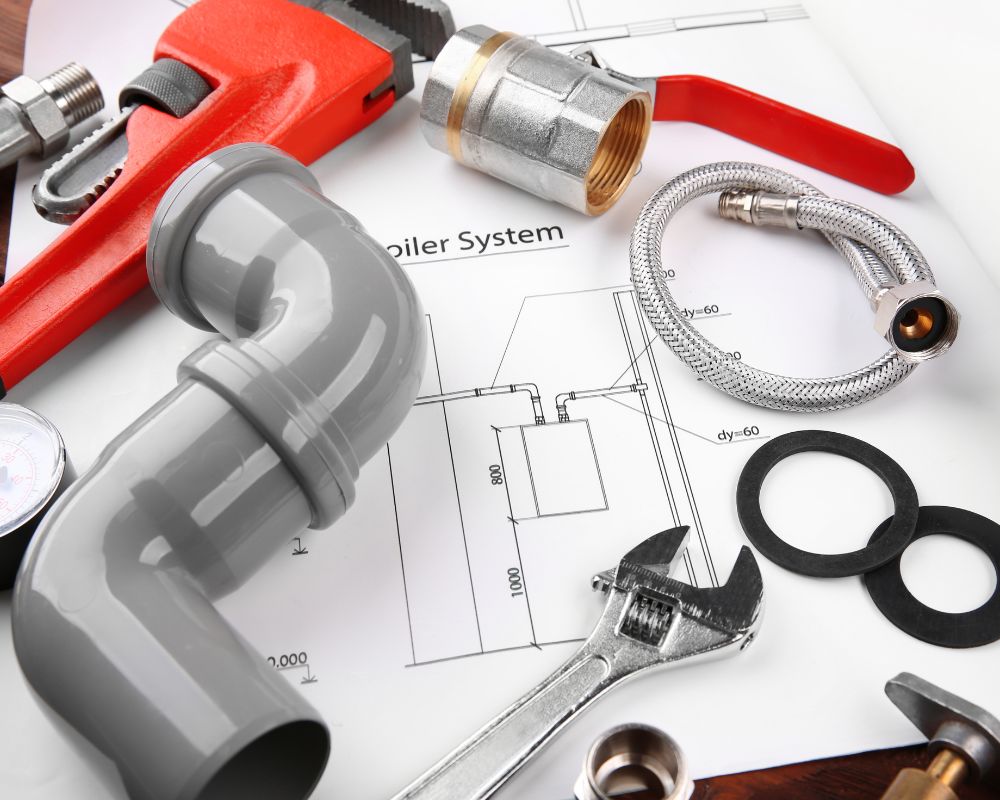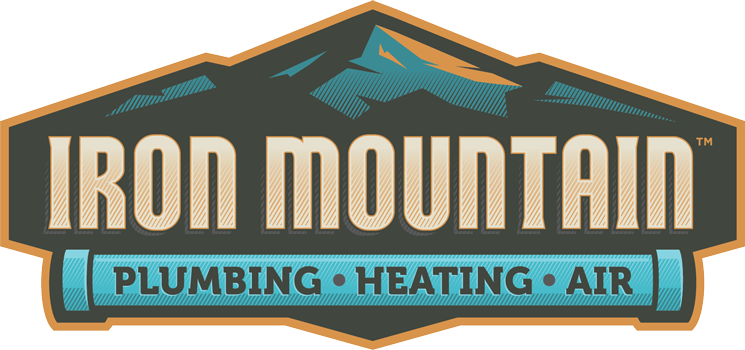
Check for Leaks
Begin by inspecting all visible pipes, fittings, and fixtures for any signs of water leakage, such as damp spots, corrosion, or pooling water. Pay close attention to areas under sinks, around toilets, and beneath any exposed piping. Use a flashlight to guarantee you don’t miss any hidden areas. Leaks can manifest as small drips or minor discoloration, so thoroughness is vital.
Next, check the joints and connections of the pipes. Confirm they’re secure and free of moisture. Sometimes, leaks can be subtle, causing only a slight dampness. Run your fingers along the joints to detect any moisture. If you feel any dampness, tighten the fittings or consider applying a plumber’s tape for a temporary fix.
Also, examine the condition of seals and caulking around your plumbing fixtures. Over time, these can degrade, leading to water seepage. If you notice any cracks or gaps, reapply the sealant to prevent future leaks.
Inspect Water Heater
Once you’ve ensured all other areas are leak-free, inspect your water heater for any signs of corrosion, unusual noises, or temperature inconsistencies. Begin by visually examining the heater’s exterior. Look for rust or corrosion, particularly around the connections and valves. Corrosion can indicate a potential leak or impending failure. Listen for odd sounds like popping or rumbling, which may suggest sediment buildup.
Check the thermostat’s temperature setting; it should ideally be around 120 degrees Fahrenheit. A higher setting can pose a scalding risk or reduce the heater’s efficiency. If you notice fluctuations in water temperature during use, it might be time to assess the thermostat or heating elements.
Here’s a quick checklist:
- Inspect for Corrosion: Examine the tank and connections for rust.
- Listen for Noises: Unusual sounds can indicate sediment or mechanical issues.
- Verify Temperature Setting: Confirm it’s set to a safe and efficient level.
- Check Pressure Relief Valve: Lift the valve’s lever to confirm it’s functioning.
Test Sump Pump
After confirming your water heater functions ideally, it’s time to test the sump pump to prevent basement flooding and maintain dry conditions. Begin by locating the sump pump in your basement or crawl space. You’ll need a bucket filled with water for the test. Carefully pour the water into the sump pit until the float rises, triggering the pump. Listen attentively for the sound of the pump activating. It should start pumping water out of the pit immediately.
Observe the discharge line outside your home to confirm the water is expelled efficiently and away from your foundation. If the pump doesn’t engage, check the power source and reset the circuit if necessary. Inspect the float switch and confirm it’s not obstructed or tangled, as this can prevent operation. Regular sump pump testing confirms it’s ready for heavy rains or melting snow, safeguarding your home from potential water damage.
Remember to check the battery backup system to see if one is installed. This backup system provides peace of mind during power outages, confirming continuous protection. By maintaining your sump pump, you’re protecting your home and serving your family and community by preventing unnecessary water damage.
Clean Drain Pipes
To maintain ideal water flow and prevent clogs, regularly clean your drain pipes using a mixture of baking soda and vinegar. This natural solution helps dislodge build-up and keeps your plumbing running smoothly. Start by pouring half a cup of baking soda down the drain, followed by equal vinegar. Allow the mixture to fizz and work its magic for about 15 minutes. Then, flush the drain with hot water to clear away loosened debris.
When cleaning drain pipes, it is crucial to be methodical:
- Frequency: Perform this cleaning routine monthly to guarantee optimal drainage and avoid the accumulation of grease, hair, and soap scum.
- Safety: Wear gloves to protect your hands from any residue that might come into contact with your skin.
- Tools: If you encounter stubborn clogs that the baking soda and vinegar cannot dissolve, use a drain snake or wire hanger.
- Prevention: Install a drain strainer to catch larger particles before they enter the pipes, reducing the likelihood of future clogs.
Examine Water Pressure
Evaluating your home’s water pressure is essential to confirm your plumbing system operates efficiently and prevents potential damage to pipes and appliances. High water pressure can cause leaks, wear out fixtures, and increase water bills, while low pressure may indicate blockages or pipe corrosion. To measure your water pressure, use a pressure gauge, which you can attach to an outdoor faucet or hose bib. First, verify all water outlets in your home are off. Then, screw the gauge onto the faucet, turn it on fully, and read the measurement. Ideal residential water pressure ranges between 40 to 60 psi.
If your reading falls outside this range, consider taking corrective actions. Installing a pressure-reducing valve (PRV) can protect your plumbing system from high pressure. Check for clogged aerators or partially closed shut-off valves if the pressure is low. Examine your pressure regulator if equipped, as it might need adjustment or replacement. Regularly monitoring your water pressure extends the life of your plumbing system and confirms a reliable water supply for daily tasks, allowing you to serve others more effectively by maintaining a comfortable and efficient home environment.
Inspect Toilet Components
Begin by removing the tank lid to examine each toilet component for wear or damage, verifying everything functions correctly to prevent leaks and inefficiencies. First, check the flapper valve, as it’s essential for a proper seal. If it’s warped or cracked, it needs replacing to avoid water wastage. Next, inspect the fill valve and float; they regulate the water level in the tank. Confirm they move freely and are adjusted to the correct height for peak performance.
Look for corrosion or mineral buildup within the tank. These can lead to malfunction or damage over time. Clean the components with a gentle brush to remove any deposits. Pay attention to the flush handle and chain, too. Confirm the chain has the right slack; excessive slack may prevent a complete flush, while too little might keep the flapper open.
Here’s a quick checklist for inspecting toilet components:
- Flapper Valve: Look for cracks or deformation.
- Fill Valve and Float: Check operation and height.
- Corrosion or Mineral Buildup: Clean as needed.
- Flush Handle and Chain: Adjust chain slack, confirming proper flush.
Check Faucet Functionality
When evaluating faucet functionality, confirm that water flows smoothly and the handles operate without resistance or leaks. Begin by turning the faucet on and off to check for ease of motion. Listen carefully for unusual sounds, such as squeaking or grinding, which might indicate worn-out components. Examine the faucet’s aerator for buildup that can affect water flow; unscrew it and clean any debris using a small brush or vinegar solution to guarantee peak performance.
Inspect the faucet’s base and spout for any signs of leaks or corrosion, which could lead to water damage or inefficiency. If you notice any drips, tighten fittings or replace washers and O-rings as needed. Pay attention to the temperature mixture; if the water isn’t reaching the desired temperatures, the issue might lie within the faucet’s cartridge or valve, which might require replacement.
Consider the faucet’s age and material. Older or inferior models might need more frequent maintenance or replacement. Always use high-quality components to extend the life of your faucets. Maintaining your faucets effectively confirms a reliable water supply, enhances your household’s efficiency, and promotes sustainability.
Inspect Sewer Lines
While ensuring faucets function smoothly, inspecting sewer lines to prevent blockages and costly repairs is equally important. By maintaining sewer lines, you’re safeguarding your home and serving others by preventing potential neighborhood disruptions. A practical approach involves a thorough evaluation to catch issues early. Here’s a technical checklist to guide you:
- Check for Slow Drains: If water is draining slowly, it might indicate a developing clog. Pay attention to all drains, including sinks, bathtubs, and toilets.
- Listen for Unusual Sounds: Gurgling sounds in pipes can signal air trapped due to a blockage. These noises often precede more severe issues.
- Look for Unpleasant Odors: Foul smells from drains suggest waste isn’t moving efficiently through the sewer system, pointing to a possible obstruction.
- Inspect Cleanout Points: Regularly examine sewer cleanout points outside your home. They should be free from debris and easily accessible for emergencies.
Examine Outdoor Plumbing
To guarantee your outdoor plumbing systems are operating at their best, meticulously inspect hoses, faucets, and sprinkler systems for leaks, corrosion, and damage. Begin by examining all hoses for cracks or brittleness, which could lead to water wastage and inefficient operation. Replace any compromised hoses immediately to prevent further damage. Check faucet handles and spouts for leaks; a simple test is to turn on the faucet and observe any water escaping from unintended areas.
Next, scrutinize your sprinkler system. Confirm that each sprinkler head is free from obstructions and functioning correctly. Misaligned or clogged heads can waste water and reduce coverage, harming plant health. Adjust or clean them as needed. Inspect the sprinkler control valves and system pressure, confirming these components operate smoothly and without leaks.
Don’t overlook the outdoor drains and gutters. Clear any debris blocking the flow, as clogged drains can lead to pooling water that damages your property. Check drainage slopes to confirm water flows away from structures, preventing damage to foundations and landscaping.
Review Water Bill for Anomalies
Carefully analyze your water bill for unexpected spikes, as they can indicate hidden leaks or inefficiencies in your plumbing system. By doing so, you’ll save money and conserve a precious resource, allowing you to serve others better. Begin by comparing your current bill to previous months. Look for patterns or anomalies in usage. If there’s a significant increase that you can’t account for, it’s time to investigate further.
Start by checking the following:
- Meter Reading Errors: Verify the meter reading on your bill matches the actual reading on your water meter. Mismatches can lead to incorrect billing.
- Irrigation Systems: Inspect your irrigation system for leaks or malfunctions, which can often go unnoticed and contribute to higher water usage.
- Leaking Fixtures: Examine all faucets, showerheads, and toilets for drips or leaks, even small ones, as they can accumulate significant water loss over time.
- Invisible Leaks: If you suspect a problem but can’t identify the source, consider hiring a professional to check for leaks in hidden pipes or underground lines.
Conclusion
Frequently Asked Questions
Related Articles
Contact Form
Have questions? Fill out the form below and a member of our team will get back to you as soon as possible.




